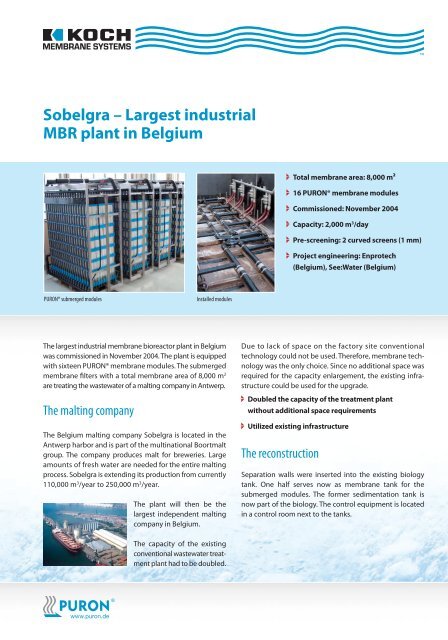Sobelgra â Largest industrial MBR plant in Belgium - Puron.de
Sobelgra â Largest industrial MBR plant in Belgium - Puron.de
Sobelgra â Largest industrial MBR plant in Belgium - Puron.de
Create successful ePaper yourself
Turn your PDF publications into a flip-book with our unique Google optimized e-Paper software.
<strong>Sobelgra</strong> – <strong>Largest</strong> <strong><strong>in</strong>dustrial</strong><strong>MBR</strong> <strong>plant</strong> <strong>in</strong> <strong>Belgium</strong>Total membrane area: 8,000 m²16 PURON® membrane modulesCommissioned: November 2004Capacity: 2,000 m 3 /dayPre-screen<strong>in</strong>g: 2 curved screens (1 mm)Project eng<strong>in</strong>eer<strong>in</strong>g: Enprotech(<strong>Belgium</strong>), See:Water (<strong>Belgium</strong>)PURON® submerged modulesInstalled modulesThe largest <strong><strong>in</strong>dustrial</strong> membrane bioreactor <strong>plant</strong> <strong>in</strong> <strong>Belgium</strong>was commissioned <strong>in</strong> November 2004. The <strong>plant</strong> is equippedwith sixteen PURON® membrane modules. The submergedmembrane filters with a total membrane area of 8,000 m 2are treat<strong>in</strong>g the wastewater of a malt<strong>in</strong>g company <strong>in</strong> Antwerp.The malt<strong>in</strong>g companyThe <strong>Belgium</strong> malt<strong>in</strong>g company <strong>Sobelgra</strong> is located <strong>in</strong> theAntwerp harbor and is part of the mult<strong>in</strong>ational Boortmaltgroup. The company produces malt for breweries. Largeamounts of fresh water are nee<strong>de</strong>d for the entire malt<strong>in</strong>gprocess. <strong>Sobelgra</strong> is extend<strong>in</strong>g its production from currently110,000 m 3 /year to 250,000 m 3 /year.The <strong>plant</strong> will then be thelargest <strong>in</strong><strong>de</strong>pen<strong>de</strong>nt malt<strong>in</strong>gcompany <strong>in</strong> <strong>Belgium</strong>.Due to lack of space on the factory site conventionaltechnology could not be used. Therefore, membrane technologywas the only choice. S<strong>in</strong>ce no additional space wasrequired for the capacity enlargement, the exist<strong>in</strong>g <strong>in</strong>frastructurecould be used for the upgra<strong>de</strong>.Doubled the capacity of the treatment <strong>plant</strong>without additional space requirementsUtilized exist<strong>in</strong>g <strong>in</strong>frastructureThe reconstructionSeparation walls were <strong>in</strong>serted <strong>in</strong>to the exist<strong>in</strong>g biologytank. One half serves now as membrane tank for thesubmerged modules. The former sedimentation tank isnow part of the biology. The control equipment is located<strong>in</strong> a control room next to the tanks.The capacity of the exist<strong>in</strong>gconventional wastewater treatment<strong>plant</strong> had to be doubled.
The treatment <strong>plant</strong>The treatment <strong>plant</strong> consists of three parts: mechanicalpretreatment, the biological step and the filtration system.After removal of the coarser parts from the barley process<strong>in</strong>gby means of two curved screens, the wastewater isfed <strong>in</strong>to the biological step of the <strong>plant</strong>, which consists oftwo tanks connected <strong>in</strong> series. The biologically cleanedwater will be separated from the activated sludge <strong>in</strong> themembrane step.control roommembrane chamberInstallation of a 500 m 2 PURON® moduleThe membrane step consists of two chambers <strong>in</strong>to whichthe PURON modules are submerged. A third chamber isavailable for future extensions of the <strong>plant</strong>. The chambersare fed from below, so that the activated sludge flowsthrough the membrane modules from bottom to top. Theclean water is drawn out of the membrane modules bymeans of a sub-atmospheric pressure.Plant overviewParameterbiologyInfluent[mg/l]former clarifierLoads[kg/d]Effluent[mg/l]COD 1880 - 2100 4000 100-200BOD 700 - 930 2000 2-5Suspen<strong>de</strong>d solids 330 - 460 800 0N total 35 - 50 100 1-2P total 13 -15 30 < 1The activated sludge is led back <strong>in</strong>to the aerated tanks.To ma<strong>in</strong>ta<strong>in</strong> the filtration rates of the membrane modules,a backwash with filtrate comb<strong>in</strong>ed with an air scour<strong>in</strong>g of themembrane modules is carried out <strong>in</strong> <strong>in</strong>tervals. The chamberscan be <strong>de</strong>coupled <strong>in</strong><strong>de</strong>pen<strong>de</strong>ntly for ma<strong>in</strong>tenancepurposes.Koch Membrane Systems GmbH Kackertstr. 10 | D-52072 Aachen | GermanyTel.: +49 (0)241 413 26 0 | Fax: +49 (0)241 413 26 59 | <strong>in</strong>fo@puron.<strong>de</strong> | www.puron.<strong>de</strong>Please visit www.kochmembrane.com for a complete list of all KMS global contactsPURON is a tra<strong>de</strong>mark of Koch Membrane Systems GmbH. PURON® is a registered tra<strong>de</strong>mark of Koch Membrane Systems GmbH <strong>in</strong> CTM Countries and Ch<strong>in</strong>a.© 2006 Koch Membrane Systems GmbH. All rights reserved worldwi<strong>de</strong>. Koch Membrane Systems GmbH is a Koch Chemical Technology Group, LLC company. 03/06



